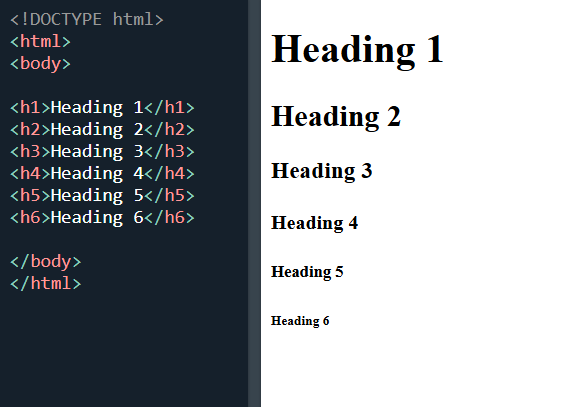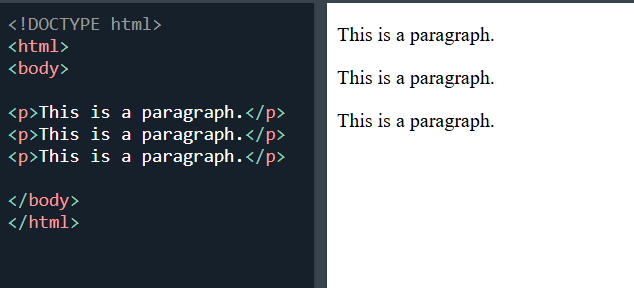HTML : Hyper Text Markup Language
HTML stands for HyperText Markup Language. It is the standard language used to create and structure the content of a webpage.
- HyperText: This refers to the ability to create links that connect web pages to one another, making the web a connected "web" of information.
- Markup Language: This means you use "tags" to surround your content, giving that content meaning and structure. You are "marking up" a plain text document.
Software Requirements
1. Install Visual Studio Code
This is a free piece of software from Microsoft that you will use to write your code. You can download it from the official website:
https://code.visualstudio.com/Install the following extensions to enhance your coding experience in Visual Studio Code:
- Live Preview
- Prettier
- Live Server
The Heading tag
Headings are tags used to define titles and subtitles on your page. They are crucial for creating a logical hierarchy and outline for your content.
HTML headings are defined with the <h1> to <h6> tags.
<h1> defines the most important heading. <h6> defines the least important heading.
Here is the defined hierarchy of the heading tags

<h1>: The most important heading, typically used only once per page for the main title.
<h2>: A major section heading.
<h3>: A sub-section heading under an <h2>.
...and so on, down to <h6>, the least important heading.
The Purpose: To structure your document in a way that is understandable to both humans and machines (like search engines and screen readers). It is not just for making text big; it is for giving the text structural importance.
The Paragraph tag
What it is: The paragraph tag is the most common tag you'll use. It's for grouping sentences and blocks of text together.
The Tag:<p>
The Purpose: To define a distinct paragraph of text. Browsers automatically add a little bit of space before and after a <p> element, separating it from other content. You should not use multiple line breaks; you should use multiple paragraph tags.
For e.g.

The Horizontal Ruler
The <hr> tag defines a thematic break in an HTML page, and is most often displayed as a horizontal rule. The <hr> element is used to separate content (or define a change) in an HTML page.
For e.g.

The Line Break Tag
The Line Break Tag: <br>
This tag tells the browser, "Stop writing on this line and immediately start on the next one." It's like hitting the Enter key once in a poem or an address.
Purpose: Creates a single line break.
For e.g.

Lists
HTML lists allow web developers to group a set of related items in lists.
There are two types of lists in HTML
- Unordered list
- Ordered list
Unordered list
An unordered list starts with the <ul> tag. Each list item starts with the <li> tag.
The list items will be marked with bullets (small black circles) by default:

Ordered list
An ordered list starts with the <ol> tag. Each list item starts with the <li> tag.
The list items will be marked with numbers by default:

The Anchor Tag (<a>)
What it is: The Anchor tag is what makes the web "hypertext." It is used to create a hyperlink to another webpage, a file, or a location within the same page.
The Tag: <a>
The Purpose: To make text (or an image) clickable, allowing users to navigate. It requires an attribute called href (hypertext reference) to specify the destination URL.
HTML Links - The target Attribute
By default, a linked page will be displayed in the current browser window. To change this behavior, you can specify a different target using the target attribute.
The target attribute specifies where to open the linked document, and it can have one of the following values:

- _self: This is the default value. It opens the linked document in the same window or tab that was clicked.
- _blank: This value opens the document in a new window or tab.
- _parent: This opens the document in the parent frame of the current document.
- _top: This opens the document in the full body of the window, breaking out of any frames.
The Image Tag (<img>)
The HTML <img> tag is used to embed an image in a web page. Images are not technically inserted into a web page; they are linked to web pages. The <img> tag creates a holding space for the referenced image.
The <img> tag is empty, contains attributes only, and does not have a closing tag.

The <img> Tag Attributes
The <img> tag has two required attributes, but also commonly uses optional attributes to control the image's dimensions:
- src: Specifies the path to the image.
- alt: Specifies an alternate text for the image.
- height: Specifies the height of the image in pixels.
- width: Specifies the width of the image in pixels.